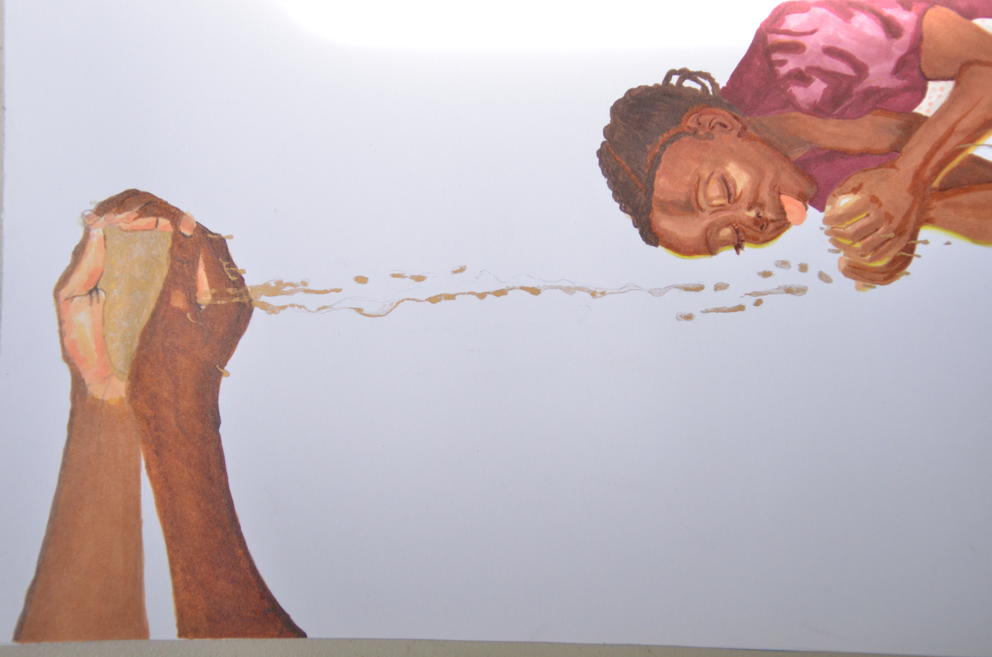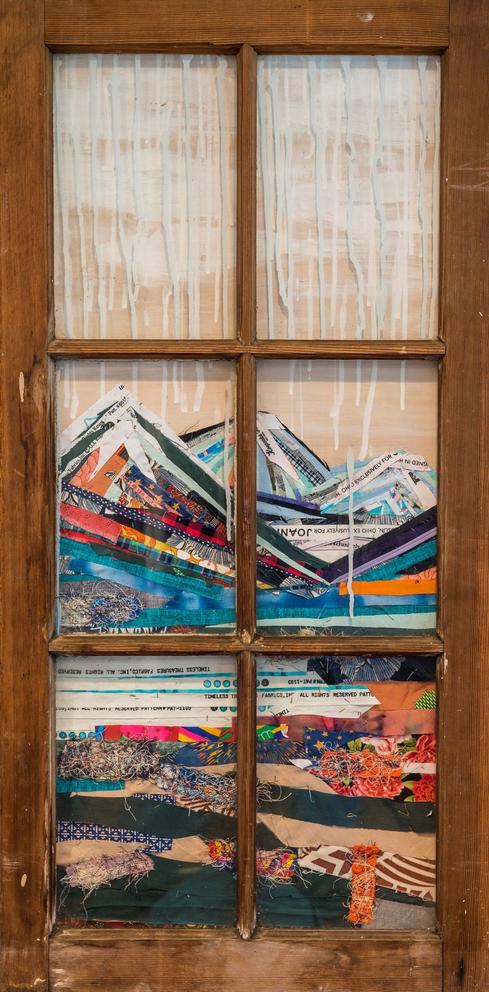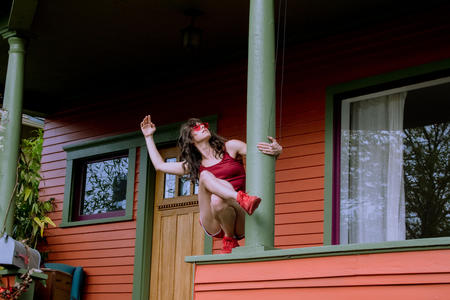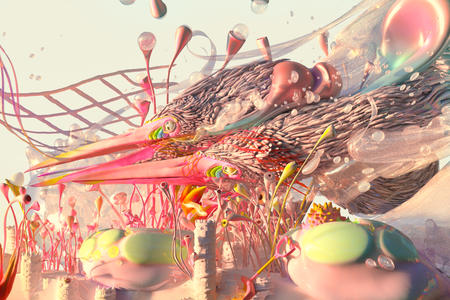Now 39 years old, Langston — a Seattle-based artist and UX designer — kicked off another round. This time, it involved more than 900 grown-up participants in nearly 500 cities across the world, all playing a part in a virtual art project called Telephone.
Started in the early days of the pandemic with a secret message sent from Langston’s West Seattle digs, Telephone worked just like the original game, though the whispering happened over the internet, from artist to artist. And every message came in the form of an artwork, which each player translated into another medium. A poem became a painting, then morphed into music or film, dance, sculpture and so on.
As the coronavirus spread across the globe, so did the project.
“This [project] was perfect for the moment,” Langston says. “It doesn't require any physical contact, for one, because it's entirely internet-based. For two: everyone … [has] been dealing with feelings of intense isolation. And Telephone is very specifically about connecting people to each other.”
Opening up your inbox, double-clicking the attachment and seeing a painting or video sent to you all the way from Melbourne or Milan, thinking about how to translate it into your own medium is “such an intimate experience,” Langston says. “It's some of the closest looking at art or listening to art or examining art that you can have.”
The resulting multimedia exhibition-meets-choose-your-own-adventure game, accessible only via a website, debuts this Saturday, April 10 — almost exactly a year after its inception, and just as the end of the pandemic starts to feel possible. As in the old game of Telephone, the fun is in the collective unveiling, Langston says. “None of the artists have seen any of this,” he says. “We’ve been holding this secret for a year. And finally, we get to spill it.”
Participants included 53 Washington state-based artists — from lesser-known to established names, such as former Washington poet laureate Kathleen Flenniken — who received and transmitted photos, paintings, drawings and poetry to and from artists in cities across the U.S., Iran, Germany and Vietnam, almost like a worldwide chain letter.
Seattle painter Anne Siems doesn’t quite remember when she got the email from Telephone organizers containing the mysterious video file but says she felt an immediate, visceral reaction. In the one-minute video, by New York artist Madeline Hoak (at the time of this writing, Siems still did not know the artist’s identity), the bird's-eye camera circles a dancer in a brown dress “dancing in a whirl of green fabric,” Siems says. “The music was tender and somewhat sad. As an amateur dancer myself I found it extremely pleasing and easy to relate to.”
Siems responded with a delicate painting on a clay panel, also featuring one person at the center: A tattooed, Renaissance-era-pale woman surrounded by a wiglike plane of gray. She stares coldly into the distance, lost in her own thoughts as a nimbus of emerald-green smoke drifts by. She holds up the back of her hands almost robotically, a bit like the dancer in the video. Her blueish knuckles show two tattoos: the words “turn” and “life” in Gothic script. “It responds to the dancer twirling in the video,” Siems says, “as well as to the idea of life events, how we have turns in life that change our trajectory.”
For most artists, the pandemic was precisely such a major twist. For Langston, too. He had instigated his first game of artistic Telephone — played in person — almost a decade earlier, with no plan to resuscitate it. Back then, in 2010, he had started off with a line from the Prayer of the Breton Fisherman: “Oh God, Thy Sea is So Great and My Boat is So Small.”
The line conveyed his loneliness at the time. He had just moved to New York City from Portland. “I felt really alone, lost in the sea of this gigantic metropolis,” Langston says. This project, he calculated, wouldn’t just be cool, it would also help him meet more local artists. It worked. After about a year of lugging around artworks on the subway, he shifted to a digital sharing system and art show, which debuted in 2015 with a total of 315 participants. But he hadn’t considered a second game.
Until the pandemic hit. Once again, Langston felt unmoored. But this time, he wasn’t alone. “The feeling that I was having when I moved from a small town of Portland to New York City, feeling lonely and lost, and a little bit scared and intimidated — that was all of a sudden a universal feeling,” he says. “This game of connecting artists, and strangers from all across the world, definitely is grounded in that same idea.”
To initiate Telephone’s most recent version, Langston settled on a short paragraph about the banyan tree, a type of giant fig tree, from Ladders to Heaven: The Secret History of Fig Trees by rainforest ecologist Mike Shanahan. Langston sent the text to six artists working in different disciplines. A few weeks later, those six artists sent their completed works back to Langston, who sent them on anonymously to two or three different artists each. “It gets pretty big pretty fast,” Langston says. “It's expanding exponentially, just as the coronavirus was at the time.”
That’s part of the reason why a passage about a tree felt like a good place to start: the artworks branch out like a “tree structure” — the same term used by software and web designers, Langston explained during a recent Zoom call. Sharing his screen, he hovered the cursor over the “game map,” a graphic outline of how (and how far) the initial message has traveled.
“Each one of these is called a node,” he says, clicking on a small square that lights up with the name and location of each artist. “And this is the parent node of these, and these are called children…. So that's kind of what we're building, this massive family tree.”
On the Telephone website, visitors can browse the tree (which looks more like a web) and click through to see which works inspired which and untangle different strands of loosely translated concepts, reinterpreted motifs. Throughout, a general sense of pandemic anxiety seeps through.
The initial short piece of prose about a tree grows into leaves on a painting, which, with a click, morphs into a Finnish artist’s barely audible soundscape that evokes trees talking to each other oh-so-quietly. Click. A GIF of leaves teeming with microscopic life from a New York artist. Click. An intricate abstract painting from a Polish artist in Dublin that seems to lay bare the inner workings of a biological cell. Click. Click. Click. Even when I retrace my steps and pick a different limb, the tree keeps growing.
Seattle artist and teacher Farah Ware created this piece of art in response to a poem, writing that it "conjured up the image of hands cupping water and the water tricking down to a young child. For me, this represents the ancestors passing on knowledge, tradition, habits, life and so many other things to the next generation." (Farah Ware)
But halfway through this year’s game, Langston (and a team of nine other artist-volunteers) started narrowing the widest part of the tree back down to a seed. Artists were assigned two or three artworks to synthesize and so forth, until all the different strands funneled back to one single piece of art — much more like the original game, which starts and ends with a single message.
Rae Armantrout, the Everett-based Pulitzer Prize-winning poet, initially had some doubts when the Telephone team asked her to join the chain and synthesize two artworks into a poem. “I was apprehensive, to be honest,” she says. “I have never been good at writing to prompts or writing for occasions. What if the artworks didn’t speak to me? What if the two pieces seemed to have nothing in common? But I took the bait. The project seemed too interesting to leave alone.”
The artworks — a collage by Bogotá-based artist Maria Jose Sánchez and a painting by Brazilian artist Andre Leal — did speak to her. And, Armantrout found, they kind of spoke to each other, too. The black vegetation found in both works suggested death and decay, though she notes: “Perhaps I saw it this way because I was living with the pandemic.” As such, the works reverberated with themes she had been mulling over: truth, distortion and “the contagion of disinformation as well as the contagion of disease,” as Armantrout puts it. In the resulting poem, called “Split,” Armantrout matched their tone of contagious danger.
Unbeknownst to her (until Saturday’s reveal), Armantrout’s poem is only five steps — a drawing, dance video, two paintings and a short story — removed from the project’s ultimate piece of art.
After hundreds of translations, what started as a message about a banyan tree came out as an instrumental piano ballad by Hong Kong artist Priscila Chu. The piece, titled “Falling into place,” is based on two pieces of art. One is a short story by Danish writer Mikkel Rosengaard, wherein he deals with the grief of “the impermanence of things.” The other is a drawing, by German artist Leeorio (aka Lennart Schütt), about hope and overcoming obstacles.
The composition is solemn, but Chu (who didn’t know her work would be Telephone’s grand finale) has sprinkled in bright notes here and there — perhaps a reflection of the multitude of emotions channeled down through to the two penultimate pieces of art. Her translation may feel familiar to Telephone artists and visitors alike: a grave, wordless grief about who and what we’ve lost this past year. But like a dark curtain with tiny moth holes, light is starting to peek through — suggesting sunshine on the other side.
“When we look back on this project in 10 years, we'll look at a time that was one of the hardest, darkest years — at least in my lifetime,” Langston says. “And we'll see that during that time, we did something exceptionally beautiful.”
Olympia artist Jenna Fettig created this multimedia collage made out of plywood, a window, mask-making scraps, sewing pins and chalk paint. "I was spending nearly all of my free time sewing cloth masks for a local mask-making group called South Salish Mighty Mask," Fettig writes, noting that "this work is made out of fabric scraps" donated by sewers in the community. (Jenna Fettig)
Get the latest in local arts and culture
This weekly newsletter brings arts news and cultural events straight to your inbox.










